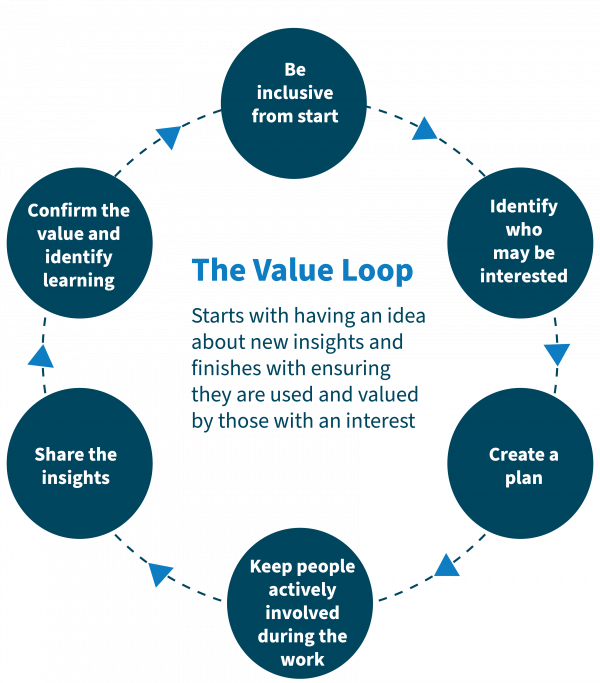Sharing Value: The Value Loop
Follow the Data Protection and Use Policy (DPUP) Value Loop when working collaboratively on new insights to develop and share the valuable results.
Understanding each step of the Value Loop
Each section in this Guideline defines a step of the Value Loop and the important things to consider at each step.

Detailed description of diagram
Six circles are set out in a loop and connected by a dotted line going in 1 direction. Each circle has a label: ‘Be inclusive from the start’, ‘Identify who may be interested’, ‘Create a plan’, ‘Keep people actively involved during the work’, ‘Share the insights’, ‘Confirm the value and identify the learning’. In the middle of the loop is the text: “The Value Loop — Starts with having an idea about new insights and finishes with ensuring they they are used and valued by those with an interest.”.
Overall objectives of the approach
Agencies need to make sure work on new insights include the right idea, right people, right information and the right use.
- Right idea: ensure the work is informed by a good understanding of the topic and is respectful of the people whose information is involved.
- Right people: ensure the people involved have interests aligned to the He Tāngata Principle — that is, they wish to improve the wellbeing of people or communities. For example, people working in and serving their communities.
- Right information: ensure that the right data is used or collected. The right data is relevant to the idea and may include both qualitative and quantitative data. Qualitative context can add significant understanding to the insights derived from quantitative data.
- Right use: ensure the value of the work is maximised through not only how it is done but also who can apply it in their own work to achieve better outcomes for people.
Things to consider
Agencies need to consider:
- if there is any risk that a person could be identified from the seemingly non-personal insights that might be shared. This can be particularly important when dealing with small population or sample sizes or where insights relate to something that affects only a small number of people, for example, a rare disease or disability.
- how this work will enhance the mana of the people the insights are about. For example, is there a development focus rather than a deficit focus in the insights being developed that considers the strengths and wellbeing of the people represented by the data rather than disadvantages and disparity?
Additional questions to ask:
- Will the community support the use of the data in this way?
- How can the work ensure no one is harmed or exposed, especially vulnerable people. For example, could insights be used to target, profile or prejudice people?
- What professional codes of conduct or ethical considerations are needed to guide this work?
- What contextual and cultural understanding is needed to fully understand the real experiences of the people behind the data so insights are relevant and accurate?
- Who will benefit from the insights?
- Who will contribute knowledge on the type of data that will be the most useful?
Utility links and page information
Last updated

